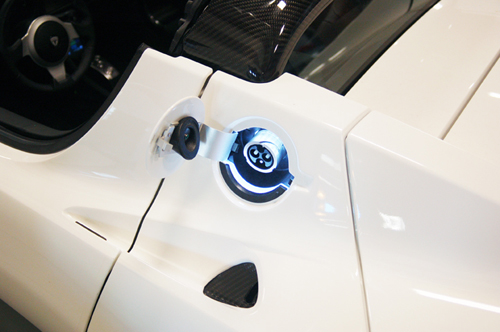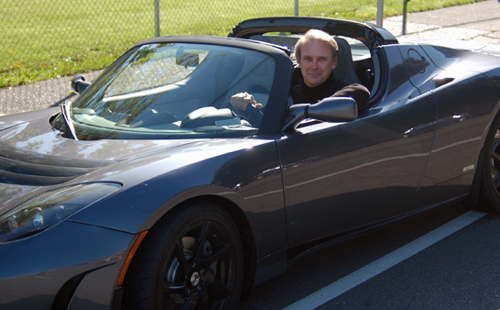As we accelerate onto Interstate 5, a Ferrari 540 pulls alongside. The driver glances over at us, smiles, nods. We get a double thumbs-up from a blonde in a rumbling V8 Mustang GT. The couple rolling along in their Prius flip us the peace sign; later, in crowded downtown traffic, even the uber cool bicycle messenger shows us her grudging approval.
It's a rare sunny fall day in Seattle and we have the top down on the all-electric powered Tesla Roadster Sport. It has neck-snapping acceleration and a top speed that is a felony everywhere but the autobahn. But it will go 245 miles on $4 worth of electricity and about the only maintenance you need is a yearly software upgrade.
Yet there's so much more to this car than just performance and efficiency. It is the epitome of good design and the future of transportation. It looks great, drives great and makes the right statement. In short, it earns high marks on all the three levels of design: visceral, behavioral and reflective.
I'm using the Tesla Roadster as an example of a product that is well designed and demonstrates the three levels of design, but you can apply the same critical evaluation to everyday products. It'll help you learn to see and think like a designer!

The Tesla's lines are clean, the proportions right, the scale is human.
An excellent example of good visceral design. Photo by the author.
Visceral design refers to the way a thing makes you feel; are the proportions right? Is the scale appropriate? Do the lines satisfy? Does its craftsmanship express quality? Does looking at it make you want to possess it? Designers know that in order for a product to be successful, people have to feel good about it. They have to want to buy it. The Tesla certainly meets this test. My first walk-around gave me goose bumps. I immediately started figuring out how I could get one. I want this car.
What can I say? It just looks right. Not so small that it comes off as a toy, which in itself is a feat of good design considering the Tesla weighs only 2,200 pounds. It's a little car but doesn't seem small. Unlike other green cars that look clunky and awkward, the Tesla gives one a sense of speed and sport without sacrificing elegance and stability. Sitting in the driver's seat made me feel really good about myself. A true test of good visceral design.
Behavioral design has to do with the way a thing performs its function. Is it easy to operate? Is there good feedback? Does it feel like an extension of your own senses? These are the considerations designers take into account when they address the behavioral aspects of a product. Because, after all, if the thing doesn't work well, people will catch on and won't want to own it.

The Tesla's plug in port lights up and makes charging in the dark a snap.
A small thing perhaps but an example of thoughtful behavioral design. Photo by the author.
The Tesla ranks high on the behavioral level of design. Of course, it's a sports car so it should handle well, but this car goes way beyond what your typical Porsche or Lamborghini can deliver. For one thing, it's a lot quicker. And I mean a lot quicker. Put the pedal down and the thing just jumps. It accelerates so fast you travel back in time. But all that torque the electric motor produces wouldn't be much good without a great suspension. Keeping the Tesla in perfect control around a cloverleaf at speed was child's play. I even tried to get the back end to break loose but the Tesla just stuck to the pavement like it was on rails.
This is not your father's Oldsmobile.
A lot of sports cars ride rough and a long trip could send you to the chiropractor. Not so with the Tesla. Sure, it's got quick steering and firm road feel, but somehow, the engineers at Tesla figured out a way to make it comfortable, too. I drove it for over an hour and emerged yearning for more. When you sit in the cockpit, it feels good. The controls are all in good view and reach. Everything is where it should be and works the way it ought to work. The word that comes to mind is intuitive. From a behavioral design perspective, the Tesla gets the gold star.
Reflective design is perhaps the hardest to rate. Reflective design has to do with what the thing says about the person who owns it. A gold Rolex says, "I've got a lot of money." A vintage pocket watch says, "I'm an individualist." A Swiss Swatch says, "I'm hip and maybe a bit funky."
People of all stripes responded positively to the Tesla. From performance enthusiasts to environmentalists to hipsters, people I encountered liked the electric Tesla. This car is a rarity in the world of design. While most products appeal only to a certain demographic, The Tesla, because of its athletic performance, green credentials and knock-out good looks, gets the nod of approval from just about everyone.

I felt good behind the wheel. The car's not too flashy and is
easily recognized as electric powered and environmentally responsible.
Reflective design at its best. Photo by the author.
And, I felt good about driving the Tesla. I was being environmentally sensitive without sacrificing great looks and performance. There is no sense of martyrdom or environmental holier-than-thou attitude about the Tesla, and people get that. It says, "I'm being responsible, but hey, I like to have fun, too, just like you."
On the reflective level of design the Tesla, again, scores big.
Now, the Tesla Roadster Sport isn't perfect. The initial cost is high, but you'll recoup that in a few years versus a Porsche 911. Also, the range is limited, if you call 245 miles on a charge a limit. But all in all, the Tesla is an example of a product that is spot on at all three levels of design.
Oh, and did our Tesla outrun the Ferrari? Let's just say that Italian job looked pretty cool in the rear view mirror.
Darby Roach is a designer and a writer and heads up his own marketing agency, Orbit Direct. His most recent book, Your Three Second Window, demystifies the design process by explaining why we like the things we like, how to see and think as a designer, and what each of us can do to introduce harmony into our lives through enhanced aesthetic experiences.
Find out more about Darby and follow his blog at DarbyRoach.com
